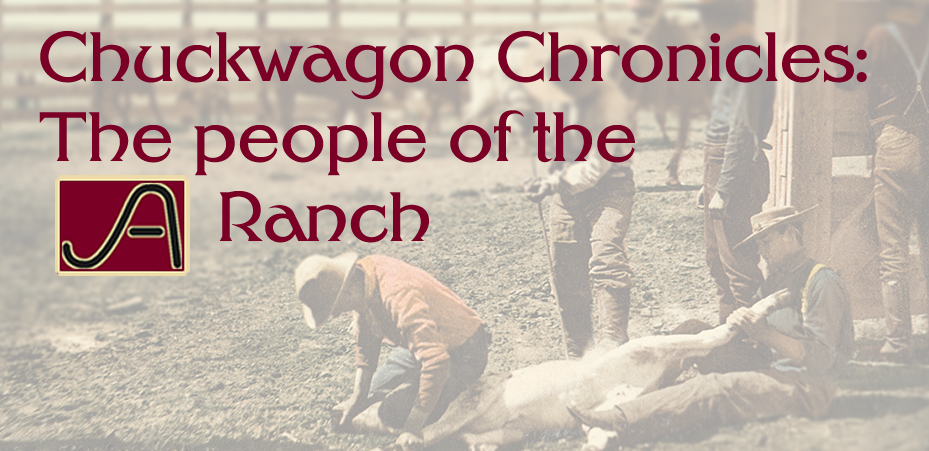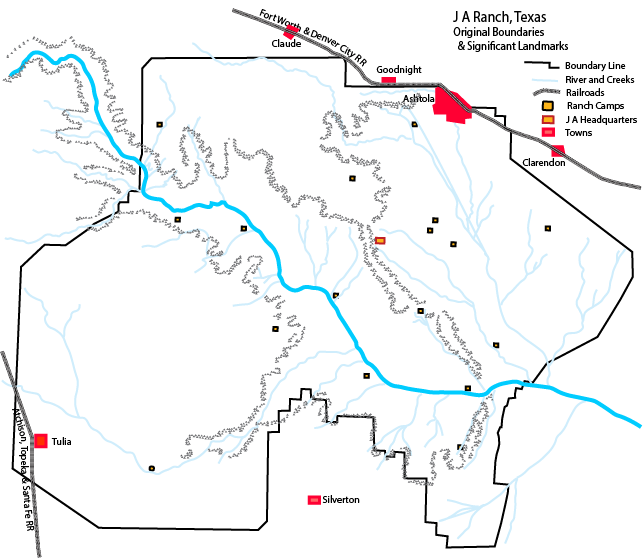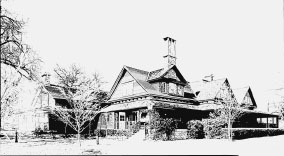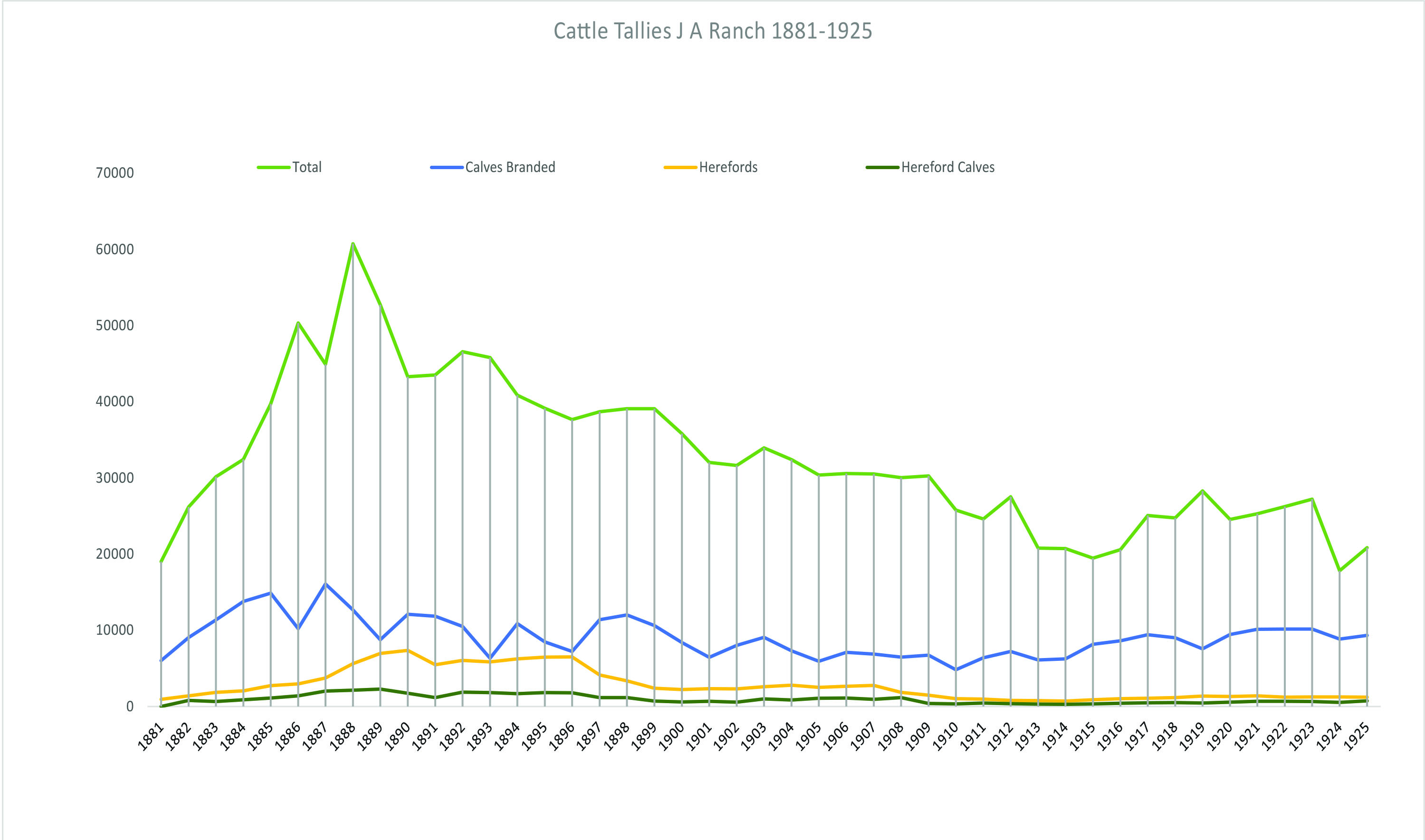 Ranch Boundaries and Infrastructure
Ranch Boundaries and Infrastructure
JA Ranch Boundaries at their largest extent. Extracted from a map by Harley True Burton, 1926. Click to enlarge.
In 1926, the Ranch was managed from a Headquarters with 16 “camp” locations. Several, if not all, of these camps included homes for the families of ranch workers, a water supply, and small farms to grow crops to feed livestock and residents. They served as important logistics points to support ranch hands assigned to remote parts of the JA. Although housing was a benefit for married hands, their wives were expected to provide compensated meals, housing, and other services for the men working in the area. A chuckwagon provided meals further afield on the range, possibly re-supplying from the camps. Charles Goodnight’s famed code of conduct for JA Ranch hands may have had a dual purpose in enforcing “civilized” behavior around these families living in isolated and vulnerable positions.
 Headquarters
Headquarters
Southwestern view of Adair house, JA Ranch Headquarters. 2001. Architectural rendering of image from the Library of Congress by Kim Nettles, 2016. Original image: http://www.loc.gov/pictures/item/tx1059.photos.223434p/
The Headquarters compound included a large and ornate home for the Adairs (constructed around the original log cabin), additional housing for employees and horses, business offices, and supply sheds. A dirt road led to Clarendon, the nearest town and shipping point.
 Cattle Counting
Cattle Counting
The Ranch was founded as a partnership between Charles Goodnight, an experienced cattleman, and John Adair, who fronted the capital for land, livestock, and expenses. Cattle were initially moved in large herds to markets in Colorado and Wyoming.
Advancing railroad lines gradually lowered the cost and time involved in shipping cattle, as well as obtaining supplies; JA business accounts were opened in each city as each new terminal was built. In 1887, the Fort Worth & Denver Railroad extended to Clarendon (near JA Ranch boundaries) and the Santa Fe Railroad extended to Panhandle, Texas (about 30 miles from the ranch.), making them shipping points for JA cattle that obviated the need for cattle drives – and likely reduced the number of hands needed to operate the ranch.
As settlers moved into the former frontier, open rangeland was increasingly constricted and disputes often turned violent. Coupled with the drought of 1895 and crashing beef prices after the end of the Spanish American War, the future was dire. The 1901 election of Theodore Roosevelt, considered a friend to the West, raised hopes for federal policies that would ease some of the pressure. Instead, Roosevelt vetoed the Lease Bill that would have given ranchers long-term access to federal land, and ordered fences on government land to come down, making it impossible to enclose existing ranges. In the great “Roosevelt Roundup”, dozens of ranchers were prosecuted for illegal fencing and land fraud.
By 1910, the days of open range were over. The JA’s herd size dropped from a peak of 60,759 head to less than 20,834 head in 1925. Many ranches did not survive the transition from free grass: the story of how the JA’s managers navigated this upheaval is likely an important research topic of its own.
"Produced by legendary cattleman Colonel Charles Goodnight, this film presents a narrative of his relationship with the Kiowa tribe who inhabited the area in and around Palo Duro Canyon and the JA Ranch. The film documents scenes from bison hunts, daily life in the Kiowa camp and the JA Ranch, and rituals and customs of the tribe. Included is footage of the last buffalo hunt that Charles Goodnight held on the ranch and invited the Kiowa to attend." Source: Texas Archive of the Moving Image http://bit.ly/1CnuX1o
"Old Texas," the silent film embedded above, was produced in 1916, the year that Iva and her parents moved to the JA Ranch. It depicts life on the ranch at the moment the "frontier" lifestyle was ceding to a "rural" culture. It was a evolution that ranchers like Goodnight at once championed and lamented.
The long-term decline in cattle tallies suggests mounting pressure to find ways to operate more efficiently and to reduce fixed costs. The 1924 plunge in cattle numbers coincides with the Moore family’s departure from the ranch, and Jesse’s turn to work driving a delivery truck instead of transferring to another ranch. Iva’s record is silent regarding the employment situation on the ranch, but it is reasonable to infer that the number of hands required to manage the herd varied with herd size, and that other Panhandle ranches may have been exeperiencing similar reductions.



